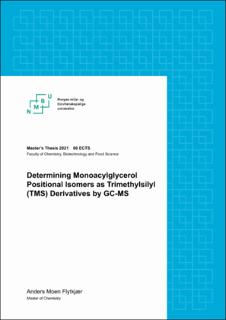| dc.contributor.advisor | Ekeberg, Dag | |
| dc.contributor.advisor | Devle, Hanne | |
| dc.contributor.author | Flytkjær, Anders Moen | |
| dc.date.accessioned | 2022-01-01T16:46:27Z | |
| dc.date.available | 2022-01-01T16:46:27Z | |
| dc.date.issued | 2021 | |
| dc.identifier.uri | https://hdl.handle.net/11250/2835663 | |
| dc.description.abstract | Monoacylglycerols (MAG) are constituents of milk lipids that are always present at low levels but also one end products of triglyceride (TAG) digestion. The most abundant type of lipids found in milk. The position at which fatty acids are bound to glycerol affects their absorption and possibly health properties (Lindmark M˚ansson, 2008)(Christie, 2010). Information on whether FA is bound to the outer 1(3) positions or the middle position 2- on the glycerol molecule is therefore useful. 2-MAG is believed to be main product of enzymatic digestion in the stomach and small intestine (Embleton & Pouton, 1997).
The most common method of qualitative- and quantitative fatty acid analysis is based on hydrolysis of these from their position on the parent molecule and subsequent methylation into FAME derivatives. The FAME method currently used in-house does not produce information on original position of FA but another derivatization method does. Trimethylsilyl (TMS) ester derivatives are easy and quick to produce, have characteristic MS fragments that can be used for identification, are selective on some GC columns and therefore suitable GC-MS analysis. Semi quantitative determination of MAG isomers as TMS esters could be coupled to the quantitative FAME analysis to add another layer of information.
Here BSTFA:TMCS was used as derivatization agent to produce TMS derivatives of MAG standards to determine descriptive fragment ions for the 1- and 2-MAG positional isomers. Both lacked the molecular ion but had a m/z [M − 15]+ as largest fragment. 1-MAG had [M − 103]+ as a unique base peak that together with [M − 15]+ could be used to identify these. 2-MAG had a fragment of m/z [218]+ of moderate intensity which was lacking for 1-MAG and a [M − 161]+ fragment that together with [M − 15]+ could be used to deduce identity. Fragmentation patterns and retention times were used to identify MAG isomers from two digested milk product samples. Identification was possible though no success was had in resolving all C18 species of MAG on the rtx-2330 GC column when both isomers were present. Most MAG was found in sn-1 position against the hypothesis that digestion produces predominantly 2-MAG but experiments on standards found that FA migration from sn-2 to sn-1 had happened during SPE separation of lipids. Attempts to reduce this by performing SPE at lower temperatures reduced the effect but did not remove it. It was concluded that TMS derivatization is promising tool for isomer determination but was not suitable on the rtx-2330 due to its low maximum temperature which makes SPE necessary to avoid TAG contamination. Changing SPE column to a type that not catalyze isomerization or changing GC column to a high temperature resistant type so that TAG can be injected could be possible solutions. | en_US |
| dc.language.iso | eng | en_US |
| dc.publisher | Norwegian University of Life Sciences, Ås | en_US |
| dc.rights | Attribution-NonCommercial-NoDerivatives 4.0 Internasjonal | * |
| dc.rights.uri | http://creativecommons.org/licenses/by-nc-nd/4.0/deed.no | * |
| dc.title | Determining monoacylglycerol positional isomers as trimethylsilyl (TMS) derivatives by GC-MS | en_US |
| dc.type | Master thesis | en_US |
| dc.description.version | submittedVersion | en_US |
| dc.description.localcode | M-KJEMI | en_US |

